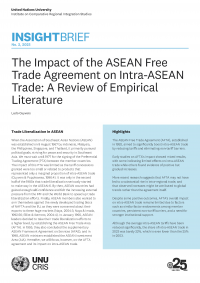The Impact of the ASEAN Free Trade Agreement on Intra-ASEAN Trade: A Review of Empirical Literature

The ASEAN Free Trade Agreement (AFTA), established in 1992, aimed to significantly boost intra-ASEAN trade by reducing tariffs and eliminating non-tariff barriers.
Early studies on AFTA’s impact showed mixed results, with some indicating limited effects on intra-ASEAN trade while others found evidence of positive but gradual increases.
More recent research suggests that AFTA may not have led to a substantial rise in intra-regional trade, and that observed increases might be attributed to global trends rather than the agreement itself.
Despite some positive outcomes, AFTA’s overall impact on intra-ASEAN trade remains limited due to factors such as similar factor endowments among member countries, persistent non-tariff barriers, and a need for stronger institutional support.
Although the average intra-ASEAN tariffs have been reduced significantly, the share of intra-ASEAN trade in 2023 was barely 22%, which is even lower than the 25% in 2003.
